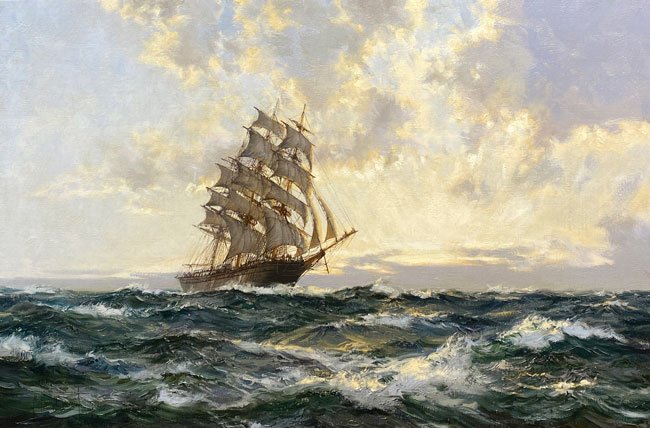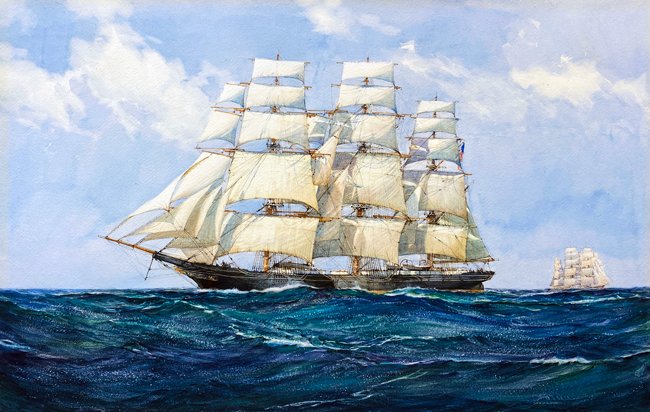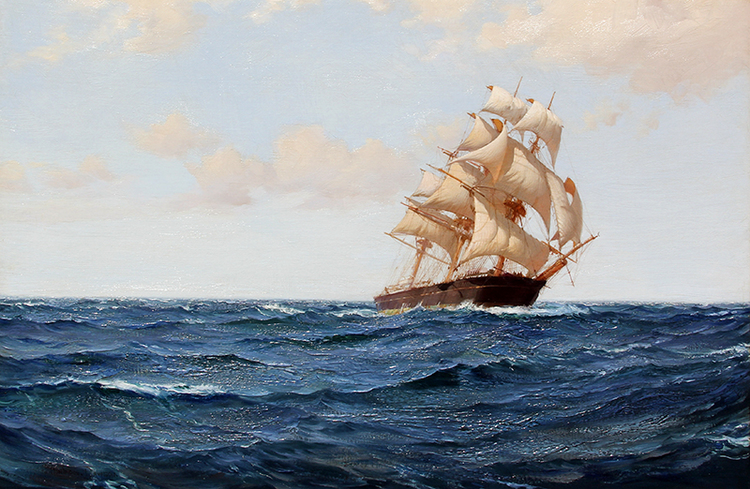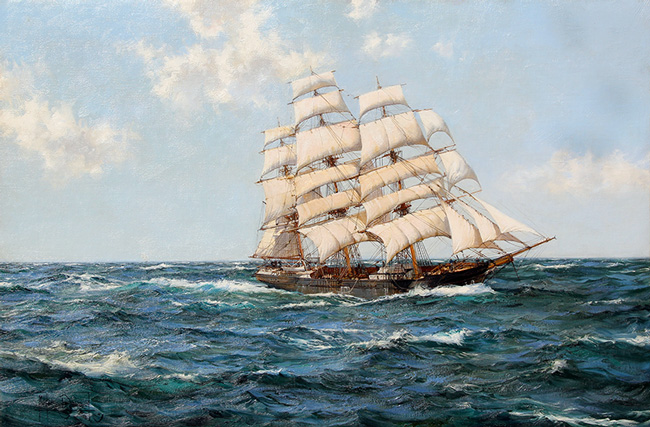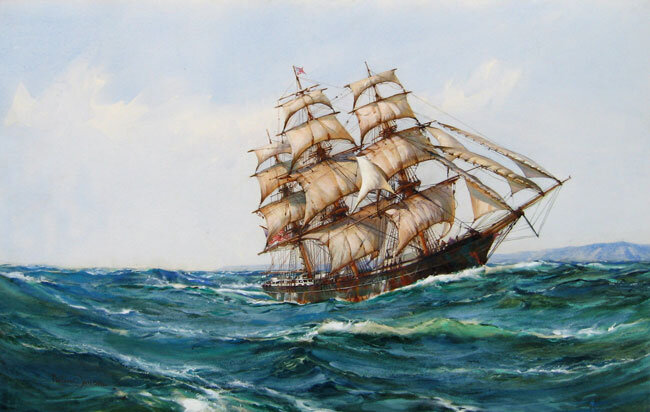MONTAGUE DAWSON PAINTINGS FOR SALE & BIOGRAPHY
MONTAGUE DAWSON
British, 1895–1973
BIOGRAPHY
Born in Chiswick in West London in 1895, Montague Dawson was the grandson of the eminent Victorian landscape painter Henry Dawson (1811-1878). He studied under the celebrated seascape artist Charles Napier Hemy (1841–1917) at the Royal Academy and also worked in an art school in Bedford Row. Dawson joined the navy during World War I and painted naval battles for illustrated magazines. He first met his mentor, Hemy, while on leave from the Royal Navy and frequented his studio in Falmouth, Cornwall. Hemy advised the young Dawson, “You must follow after me and you must do better than me.”
After the war Dawson became a frequent exhibitor at the Royal Academy and began a life-long exclusive relationship with the London gallery Frost & Reed. He was also an associate of the Royal Society of Artists and a member of the Royal Society of Marine Artists. He was appointed as an official war artist during World War II.
Montague Dawson’s paintings are instantly recognizable. He developed a style and approach to marine painting that was entirely his own and consistent throughout his long developing career. Dawson combined what he called ‘portraits’ of clipper ships and racing yachts with ‘landscapes’ at sea in order to lure the viewer into “that moment of time”, as he said, in which “you can hear the sea –that sea.” The dazzling array of oceans and skies in Dawson’s work is encapsulated by his evocative titles such as “Song of the Sea” or “Vast Heaving”. Dawson was as at ease painting Queen Elizabeth’s Royal Yacht “Bluebottle” racing in the Solent as he was summoning the great clipper ship “Cutty Sark” from its noble past.
“Shortly before his death in 1973,” writes Ron Ranson in his 1993 monograph, “a remarkable tribute was made to Montague Dawson. He looked out of his window one day to see two fully rigged training ships, the Royalist and the Sir Winston Churchill, apparently sailing straight towards his house on the shore. At what appeared to be the very last moment, they turned about, and both ships dipped their ensigns in salute to the man who had probably done more than any other to capture the magic and majesty of sail” (Ron Ranson, The Maritime Paintings of Montague Dawson, Newton Abbot, Devon, 1993, p. 15).
Museum Collections:
British Museum, London
Cambridge University Library, Cambridge
Fusilier Museum, London
Historic Dockyard, Chatham
Imperial War Museum, London
Kalamazoo Institute of Arts, Kalamazoo, MI
Laing Art Gallery, Newcastle upon Tyne
Mariners Museum, Newport News, VA
McLean Museum and Art Gallery, Greenock
National Maritime Museum, Greenwich
National Museum of the Royal Navy, Portsmouth
National Museums Collection Centre, U.K.
National War Museum, Edinburgh
North Carolina Museum of Art, Raleigh, NC
Phoenix Art Museum, Phoenix, AZ
Sir Max Aitken Museum, Cowes, Isle of Wight
Southampton City Art Gallery, Southampton
Tyne and Wear Museum, Newcastle upon Tyne
Mark Murray Fine Paintings is a New York gallery specializing in buying and selling 19th century and early 20th century artwork.
Please contact us if you are interested in selling your Montague Dawson paintings or other artwork from the 19th century and early 20th century.
MONTAGUE DAWSON
Paintings for sale
Additional Montague Dawson Paintings for Sale
Montague Dawson: An Appreciation
Touch below to watch the movie
Montague Dawson Paintings Previously Sold
MONTAGUE DAWSON
The Clipper Ship "South Australian"
Oil on canvas
42 x 28 inches (107 x 71 cm)
SOLD
MONTAGUE DAWSON
The Privateer - The "Hornet"
Oil on canvas
24 x 36 inches (61 x 91.5 cm)
SOLD
MONTAGUE DAWSON
The Gallant Fight - The Capture of the "Cleopatre" by the "Nymphe"
Oil on canvas
40 x 50 inches (101.5 x 127 cm)
SOLD
MONTAGUE DAWSON
The Billowing Ocean, The Clipper Ship “Titania” Oil on canvas
40 x 50 inches (101.5 x 127 cm)
SOLD
MONTAGUE DAWSON
The "Carrie Reed" under Full Sail
Oil on canvas
20¼ x 24¼ inches (51.4 x 61.6 cm)
SOLD
MONTAGUE DAWSON
Rounding the East Lepe Buoy in the Solent
Oil on canvas
20 x 30 inches (50.8 x 76.2 cm)
SOLD
MONTAGUE DAWSON
The Great Race - “Ariel” and “Taeping”
Oil on canvas
40 x 50 inches (101.5 x 127 cm)
SOLD
MONTAGUE DAWSON
The New York Clipper Ship “Prima Donna”
Oil on canvas
28 x 42 inches (71 x 106.7 cm)
SOLD
MONTAGUE DAWSON
Pacific Rollers - The Boston Clipper “Southern Cross”
Oil on canvas
28 x 42 inches (71 x 106.5 cm)
SOLD
MONTAGUE DAWSON
A Close Race
Watercolor on paper
17 x 26¾ inches (43.2 x 68 cm)
SOLD
MONTAGUE DAWSON
The ’Frisco Clipper - “The Sovereign of the Seas”
Oil on canvas
24 x 36 inches (61 x 91.5 cm)
SOLD
MONTAGUE DAWSON
All Well - The Famous “Leander”
Oil on canvas
20 x 30 inches (50.8 x 76.2 cm)
SOLD
MONTAGUE DAWSON
The Crusader
Oil on canvas
28 x 36 inches (70.5 x 91 cm)
SOLD
MONTAGUE DAWSON
Morning Cloud
Oil on canvas
16 x 20 inches (40.6 x 51 cm)
SOLD
MONTAGUE DAWSON
Sea Action
Oil on canvas
28 x 42 inches (71 x 106.7 cm)
SOLD
MONTAGUE DAWSON
Yachts Racing up the Clyde, Scotland
Oil on canvas
25 x 40 inches (78.7 x 116.8 cm)
SOLD
MONTAGUE DAWSON
A Clipper Ship on the High Seas
Oil on canvas
30½ x 34½ inches (77.5 x 87.5 cm)
SOLD
MONTAGUE DAWSON
A Ship Going Sailing - “The Light Brigade”
Oil on canvas
24 x 36 inches (61 x 91.5 cm)
SOLD
MONTAGUE DAWSON
Fairwinds: The China Clipper “Maitland”
Oil on canvas
24 x 36 inches (61 x 91.5 cm)
SOLD
MONTAGUE DAWSON
On the Spanish Main
Oil on canvas
24 x 36 inches (61 x 91.5 cm)
SOLD
MONTAGUE DAWSON
The Boston Clipper “Westward Ho”
Oil on canvas
28 x 42 inches
SOLD
MONTAGUE DAWSON
The Speedy “Lightning"
Oil on canvas
24 x 36 inches
SOLD
MONTAGUE DAWSON
The American Clipper - “Flying Cloud”
Oil on canvas
16 x 20 inches (40.6 x 51 cm)
SOLD
MONTAGUE DAWSON
The Buccaneers, Gorgona
Oil on canvas
40 x 50 inches (101.5 x 127 cm)
SOLD
MONTAGUE DAWSON
The Clipper Ship H.M.S. “Albion”
Watercolor and gouache on paper
30 x 40 inches (76.2 x 101.5 cm)
SOLD
MONTAGUE DAWSON
The Chase - The East Indiaman “Mellish”
Oil on canvas
30 x 22 inches
SOLD
MONTAGUE DAWSON
A Westerly Trade Wind – The Boston Clipper "Southern Cross"
Oil on canvas
20 x 30 inches (50.8 x 76.2 cm)
SOLD
MONTAGUE DAWSON
Picking up the Pilot - “The Cliffe” - Crest of the Wave - built in 1853
Oil on canvas
20 x 30 inches (50.8 x 76.2 cm)
SOLD
MONTAGUE DAWSON
Rippling Solent
Oil on canvas
20 x 30 inches (50.8 x 76.2 cm)
SOLD
MONTAGUE DAWSON
Blue Skies - “The Shun Lee”
Oil on canvas
24 x 36 inches (61 x 91.4 cm)
SOLD
MONTAGUE DAWSON
United States Clipper Ship “Winona” (1929)
Oil on canvas
28 x 40 inches (71.8 x 102 cm)
SOLD
MONTAGUE DAWSON
Nearing Port - The “Mary Glover”
Watercolor on paper
17 x 26¾ inches (43.2 x 68 cm)
SOLD
MONTAGUE DAWSON
The Western Ocean Packet - The “Cornelius Grinell”
Oil on canvas
20 x 30 inches (50.8 x 76.2 cm)
SOLD
MONTAGUE DAWSON
Atlantic Crossing - “The Ivanhoe”
Oil on canvas
30 x 50 inches (76.2 x 127 cm)
SOLD
MONTAGUE DAWSON
The Cutty Sark
Watercolor on paper
18¼ x 23½ inches (46.3 x 59.7 cm)
SOLD





